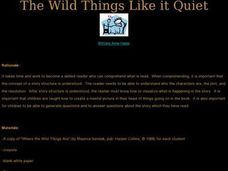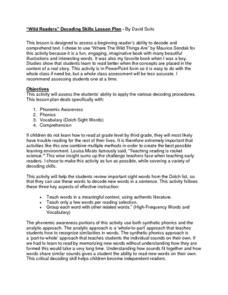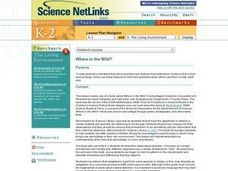Curated OER
The Wild Things Like it Quiet
Students read Where the Wild Things Are by Maurice Sendak. They visualize what is happening in the book and then identify the main points of the story. Students write a summary of the book and draw a picture of what they visualized...
Curated OER
It's All About Expression: Growing Independence and Fluency
In an engaging anticipatory set, the teacher uses several different strategies to activate prior knowledge about reading with expression, including using sentence strips (that must be prepped ahead of time) to show different moods. The...
Curated OER
Going Graph-y
Second graders listen to and dicuss the story Where the Wild Things Are. They play a pantomime game and act out various feelings so their classmates can guess. They listen for the frequency of certain words, and record their findings on...
David Suits
“Wild Readers” Decoding Skills Lesson Plan
Set young readers on the path toward fluency with this phonemic awareness resource. Based on the award-winning children's book, Where the Wild Things Are, this lesson allows beginning readers to practice isolating phonemes and...
Curated OER
What Are We Reading for Again?
Students work to develop comprehension strategies. Through modeling and guided practice they develop a series of questions as they read Where the Wild Things Are. They apply these questions to find answers about the text and make...
Curated OER
Monster Voices
Students create stories based upon the techniques of author Maurice Sendak in Where the Wild Things Are. They use a word processing program and the Apple software program GarageBand to create new voices for the story. This lesson is...
Curated OER
Writing for Different Purposes and Audiences
Third graders explore how to write for different purposes and for a specific audience or person. They read, Where the Wild Things Are by Maurice Sendak. Students create a class book after reading the story. They each create their own...
Curated OER
Visualizing While Reading
Third graders listen to the story Where the Wild Things Are, and draw pictures to illustrate what they think is happening. Students share their visualizations with their partners.
Curated OER
Where the Wild Things Shouldn't Be
Students compare and contrast wild and domestic animal needs. In this animal welfare lesson, students read the poem Where the Wild Things Shouldn't Be and create a list of wild and domestic animals. Students create a short play or song...
Curated OER
Wild Words
First graders use action spelling. In this high frequency words lesson students are read the book Where the Wild Things Are by Maurice Sendak. Students add words to the classroom wall that are in the book. Students act out words from the...
Curated OER
Texture: Wild Things
Young scholars experiment with different kinds of marking techniques. They read "Where the Wild Things Are" and observe animals for pattern and line. They compare illustrations with Haring's images. They create a symbolic drawing of animal.
Curated OER
What's Wild
Third graders discover the differences between wild and domestic animals. In this animal lesson, 3rd graders chart the differences in the animals and look through magazines for pictures of wild and domestic animals to glue to a poster....
Curated OER
Third Person Point of View
Have your class practice determining whose point of view is being utilized throughout the course of a story. They begin by working as a class to create a chart which will provide textual examples that describe first and third person...
Curated OER
Where in the Wild?
Students investigate the purpose of animals' ability to camouflage. In this animal science lesson, students read the text Where in the Wild? and identify animals that are predators and prey. Students discuss how camouflage is necessary...
Curated OER
Thumbs Up For Expert Readers!
Students use the cross check strategy to increase reading comprehension in this lesson. They listen as the teacher reads "Where the Wild Things Are." The teacher purposely reads some words wrong so that the story does not make sense. ...
Curated OER
Map Making
Students examine a variety of strategies to identify the structure of a story. They listen to the book Where the Wild Things Are and, as a class, complete a story element chart. Students independently read a passage from Charlotte's...
Curated OER
Beginning, Middle and Ending
First graders identify the beginning, middle and ending of the story "Where the Wild Things Are". They also listen to different songs and identify the beginning, middle and ending. They create their own story and identify the different...
Curated OER
Writing: Mentor Text Lesson & Microteaching
Mentor texts are a great way to demonstrate how to write with purpose. Pupils will be reintroduced to two well-known books and then asked to think about them from the writer's point of view. They will see that the author had to use basic...
Science Matters
Island Fox Outreach
Off the coast of California lives a wild animal called the Island Fox. Experts discuss the importance of the Island Fox to the Channel Islands and the balance the fox creates within its ecosystem. The lesson concludes with a reading of...
Curated OER
Reading Faster with Wild Thing
Learners practice one-minute oral readings to increase their speed and fluency. They review several reading strategies, and then they read orally with a partner. The partner times their reading with a stopwatch and tracks their time on...
Curated OER
Comprehending Through Questioning
Elementary schoolers observe and apply a variety of reading comprehension strategies. They silently read a passage out of their science textbook, and discuss answering the who, what, where, when, and how of the text. In small groups they...
Curated OER
Chicken Soup with Rice Extension Activities
After reading Chicken Soup with Rice, by Maurice Sendak, incorporate some of these great extension activities into your lesson plan. Ideas include focusing on knowing the months of the year, or studying the illustrations and how they are...
Curated OER
What's Wild?
Third graders define domesticated animal and wildlife. In this animal lesson, 3rd graders cut pictures out of magazines of both types of animals and make two collages with the pictures.
Curated OER
What's Wild?
Third graders examine pictures of animals before deciding if it is a wild animal or a domesticated animal. They discuss the difference between the two types of animals, where they live, what they eat, and what they need to survive. Using...

























